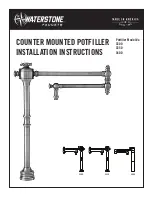
37
Wavin AS+
Technical Manual
Fig. 20: Changes of direction with 45 ° bend.
Fig. 21: Shafts with changes of direction.
Installation
Underground and collector pipes are non-accessible pipes,
installed below ground or in foundations, for the disposal of
waste water (normally via the connecting sewer). The use of
collecting pipes instead of underground and collector pipes
is preferred inside buildings, as collecting pipes are easy to
inspect, repair and maintain. This does not apply to buildings
without a basement. In these cases, the underground and col-
lector pipes leading out of the building area should be kept as
short and as straight as possible.
Underground and collector pipes should only be used with
drainage sources that are beneath the backflow level and
connected to a waste water pump or anti-flooding valve if
connection to a collecting pipe is not possible (e.g. floor
drains, showers and bathtubs). See also DIN 1986-30.
Careful planning of the underground and collector pipe
system is required, as mistakes at the planning and execution
stage are difficult to correct later. The spatial location of the
underground and collector pipe system is determined by the
arrangement of the downpipes, which should make possible
(if the layout of the basement permits) an array of various
downpipes under the cellar ceiling with as few connections to
underground and collector pipes as possible.
Buried underground and collector pipes must measure at
least DN 100.
All branches used with underground and collector pipes
must have an angle of 45°. Double branches are not
permitted.
Changes of direction should be carried out using
≤ 45° bends.
Changes of direction with 45° bends located outside the
building should be in open or enclosed shafts.
The diameter of an underground and collector pipe must
not become smaller along its direction of flow.
Ventilation pipes
Proper aerating and venting are vital for ensuring the correct
functioning of the drainage system. Correctly functioning ven-
tilation prevents vacuums and build-ups of excess pressure
in the system. Sewage fumes are dissipated, and there is no
emptying of the sink traps that prevent smells.
DIN 1986-100 differentiates between waste water drainage
systems as follows:
Single pipe with primary ventilation
Collecting pipe with primary ventilation
Air-circulation conduit
Bypass pipe
Single pipe with primary ventilation
A single pipe with primary ventilation is widely used in small
and medium-sized waste water systems.
Downpipes transport both waste water and air at the same
time. A pipe with primary ventilation, which is of the same dia-
meter as the downpipe, runs straight up to above roof level.
Each downpipe or ventilation pipe should normally run up to
above roof level.
















































